Fatigue Damage Assessment in AL6XN Stainless Steel Based on the Strain-Hardening Exponent n-Value
Abstract
1. Introduction
2. Materials and Methods
3. Results
3.1. Strain-Controlled Fatigue Testing
3.2. Tensile Tests of Specimens with AFD
3.3. Relationship Between Mechanical and Electrical Properties of AFD Specimens
3.4. Fatigue Damage Assessment
4. Conclusions
- The LCF data revealed that the AL6XN stainless steel material exhibited a cyclic true stress–strain behavior with larger strength values than the corresponding one from the tensile test reference values, i.e., the strain-hardening exponent n-value. This corresponds to a hardening cyclic mechanism. This cyclic behavior was determined based on the stable hysteresis loops with different strain amplitude levels applied ( = 0.002, 0.004, 0.006, 0.008 and 0.01). The cyclic yield strength was around 500 MPa, while the reference values were around 358 MPa.
- The AFD specimens revealed a ductility reduction in the cyclic true stress–strain behavior with respect to the reference one, which depended on the applied strain amplitude level. This ductility reduction was more severe when it was applied to the larger strain amplitude value = 0.008 and a damage index of 0.75. It found a competitive mechanism, where fatigue micro-cracks and striations produced by the AFD and during the interrupted tensile tests resulted in a larger quantity and size of micro-voids, which defined the cyclic true stress–strain behavior in the 0.75 AFD specimen.
- The strain-hardening exponent n-value was affected by the AFD. It exhibited an inverse linear relationship with respect to the AFD. The n-value was 0.39 for the specimen without AFD, and decreased up to around 0.14 for the specimen with an AFD of 0.75. Regarding the electrical resistivity, it exhibited an increasing non-linear behavior as a function of increasing the AFD. The ρ-value was 9.2 × 10−7 Ω·m for the specimen without AFD, and increased up to around 8.7 × 10−5 Ω·m for the the specimen with an AFD of 0.75. Both the n- and ρ-values were sensitive to the AFD.
Author Contributions
Funding
Data Availability Statement
Acknowledgments
Conflicts of Interest
References
- Pook, L.E. Metal Fatigue; Springer: Berlin/Heidelberg, Germany, 2007; Volume 145. [Google Scholar]
- Dowling, N.E. Mechanical Behavior of Materials; Pearson Education: London, UK, 2012. [Google Scholar]
- ASM International Handbook, Fatigue and Fracture; ASM International: Almere, The Netherlands, 1996; Volume 19.
- Zhang, W.; Cai, Y. Continuum Damage Mechanics and Numerical Applications; Springer: Berlin/Heidelberg, Germany, 2010. [Google Scholar]
- Chaboche, L. Continuous damage mechanics—A tool to describe phenomena before crack initiation. Nucl. Eng. Des. 1981, 64, 233–247. [Google Scholar] [CrossRef]
- Lemaitre, J. A Course on Damage Mechanics, 2nd ed.; Springer: Berlin/Heidelberg, Germany, 1996. [Google Scholar]
- Lemaitre, J. How to use damage mechanics. Nucl. Eng. Des. 1984, 80, 233–245. [Google Scholar] [CrossRef]
- Lemaitre, J.; Dufailly, J. Damage measurements. Eng. Fract. Mech. 1987, 28, 643–661. [Google Scholar] [CrossRef]
- Whitworth, I.; Thickpenny, J. Fatigue Damage Monitoring; Royal Military College of Science: Swindon, UK, 1980; pp. 263–266. [Google Scholar]
- Socha, G. Experimental Investigations of Fatigue Cracks Nucleation, Growth and Coalescence in Structural Steel. 2003. Available online: www.elsevier.com/locate/ijfatigue (accessed on 17 February 2025).
- Socha, G. Prediction of the fatigue life on the basis of damage progress rate curves. Int. J. Fatigue 2004, 26, 339–347. [Google Scholar] [CrossRef]
- Bjørheim, F.; Siriwardane, S.C.; Pavlou, D. A review of fatigue damage detection and measurement techniques. Int. J. Fatigue 2022, 154, 106556. [Google Scholar] [CrossRef]
- Ramírez-Acevedo, D.; Ambriz, R.R.; García, C.J.; Mendoza, C.; Jaramillo, D. Strain Measurement during Quasi-Static and Cyclic Loads in AL6XN Material Using Digital Image Correlation Technique. Materials 2024, 17, 3697. [Google Scholar] [CrossRef] [PubMed]
- Sonsino, C.M. The influence of coldforming on the low cycle fatigue behavior of the fine-grained structural steel Fe E 47 and the age-hardened aluminium alloy AICuMg2. Int. J. Fatigue 1984, 6, 173–183. [Google Scholar] [CrossRef]
- Kanda, Y.; Kariya, Y.; Oto, Y. Influence of cyclic strain-hardening exponent on fatigue ductility exponent for a Sn-Ag-Cu micro-solder joint. J. Electron. Mater. 2012, 41, 580–587. [Google Scholar] [CrossRef]
- Niu, X.; Li, G.; Lee, H. Hardening law and fatigue damage of a cyclic hardening metal. Eng. Fract. Mech. 1987, 26, 163–170. [Google Scholar]
- Allegheny Technologies Incorporated. ATI AL6XN ® Alloy; ATI Properties, Inc.: Albany, OR, USA, 2010; no. PA. [Google Scholar]
- ATI Flat Rolled Products. Certificate AL 6168-8 0417; ATI Flat Rolled Products: Pittsburgh, PA, USA, 2020. [Google Scholar]
- ISO 12106:2017; Metallic Materials—Fatigue Testing—Axial—Strain—Controlled Method. Internacional Organization for Standardization: Geneva, Switzerland, 2017.
- Nobile, R.; Saponaro, A. Electrical resistance measurements for fatigue damage prediction of AISI 316L stainless steel. Procedia Struct. Integr. 2022, 41, 421–429. [Google Scholar] [CrossRef]
- González-Zapatero, W.F.; García, C.J.; Gómora, C.M.; Ambriz, R.R.; Jaramillo, D. Low Cycle Fatigue and Damage Evaluation on 16MnCr5 Alloy Steel. Steel Res. Int. 2024, 95, 2300888. [Google Scholar] [CrossRef]
- ASTM E739–23; Practice for Statistical Analysis of Linear or Linearized Stress-Life (S-N) and Strain-Life (-N) Fatigue Data. ASTM International: West Conshohocken, PA, USA, 2023. [CrossRef]
- ASTM International. ASTM International. ASTM International Designation E8/E8M-22. In Standard Test Methods for Tension Testing of Metallic Materials; ASTM Committee E28; ASTM International: West Conshohocken, PA, USA, 2022. [Google Scholar] [CrossRef]
- Nobile, R.; Saponaro, A. Real-time monitoring of fatigue damage by electrical resistance change method. Int. J. Fatigue 2021, 151, 106404. [Google Scholar] [CrossRef]
- Chow, C.L.; Wei, Y. A Model of Continuum Damage Mechanics for Fatigue Failure; Kluwer Academic Publishers: Norwell, MA, USA, 1991. [Google Scholar]
- Mizuno, M.; Zhu, S.; Kagawa, Y.; Kaya, H. Stress, Strain and Elastic Modulus Behavior of SiC/SiC Composites during Creep and Cyclic Fatigue. J. Eur. Ceram. Soc. 1998, 18, 1869–1878. [Google Scholar] [CrossRef]


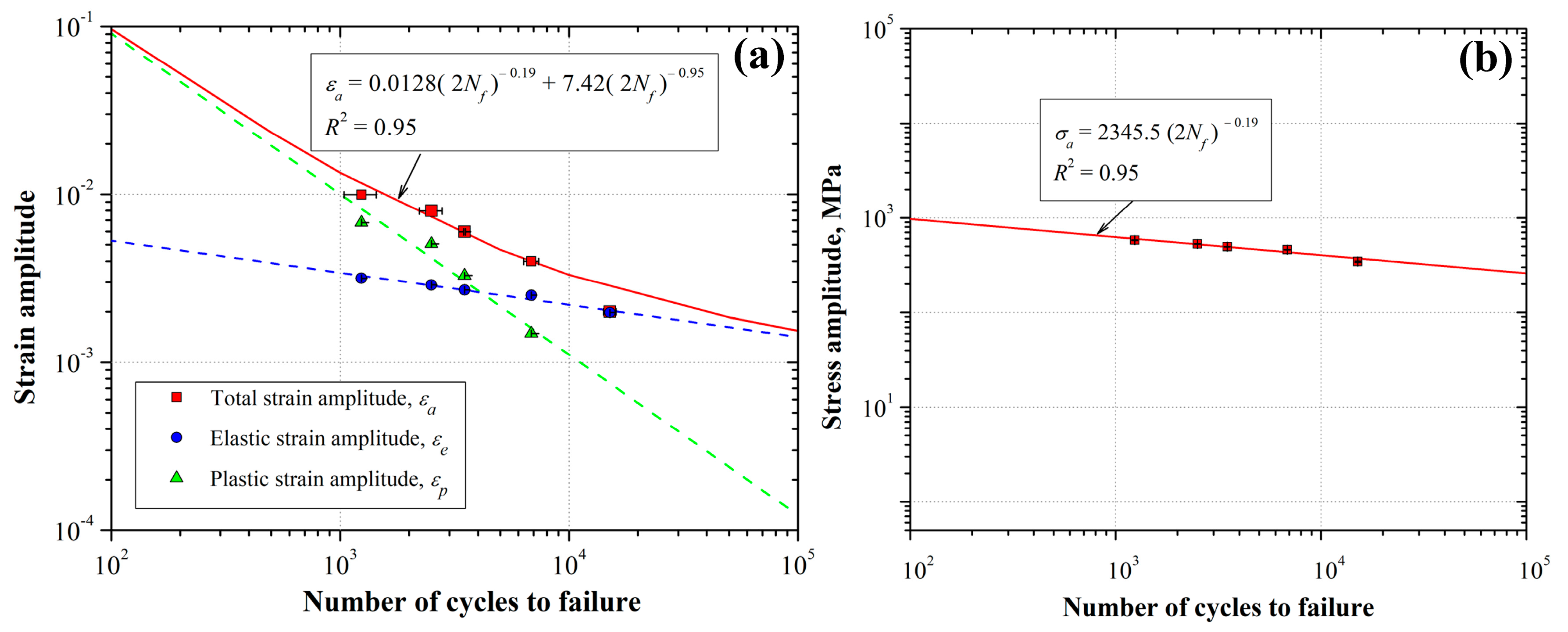



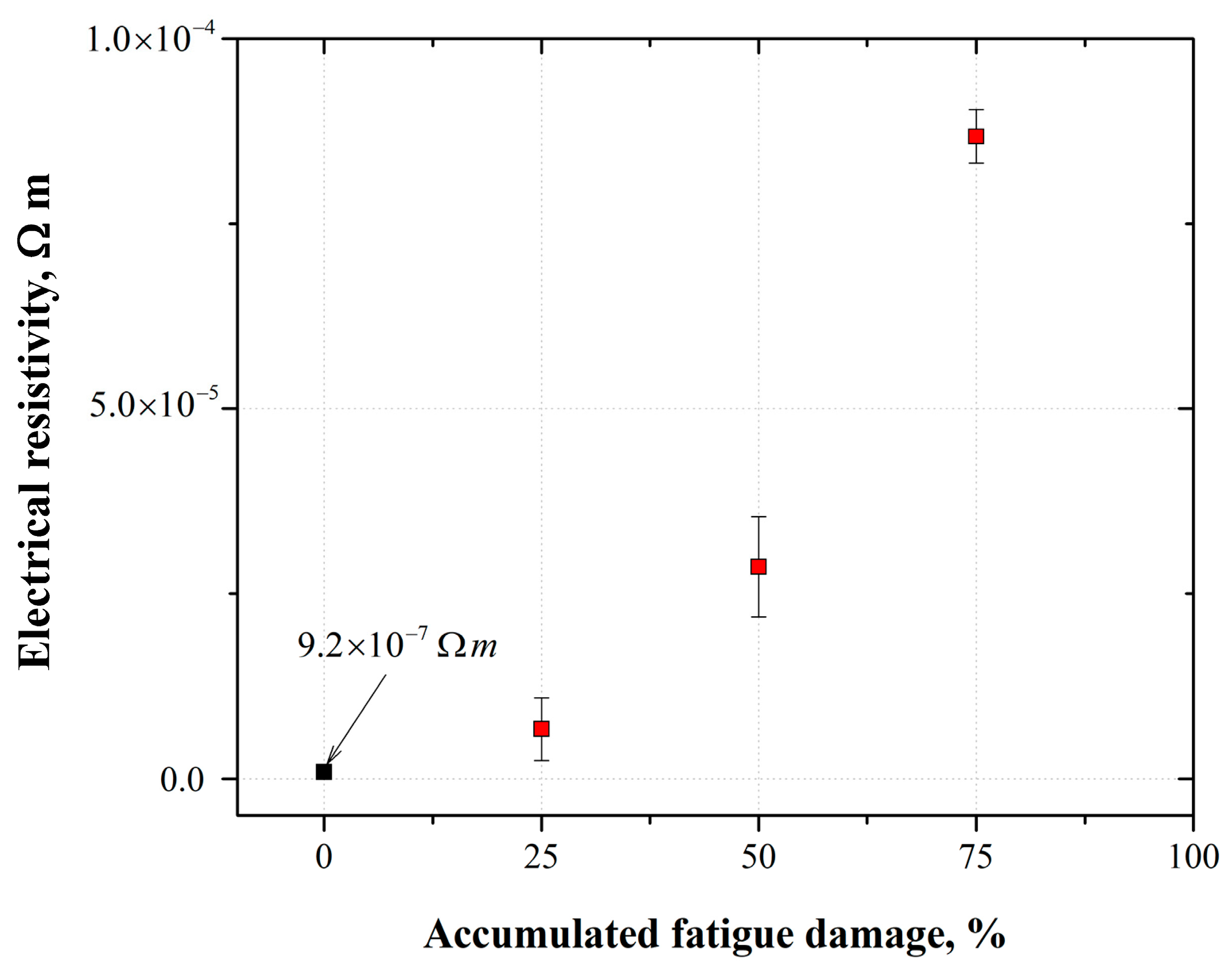
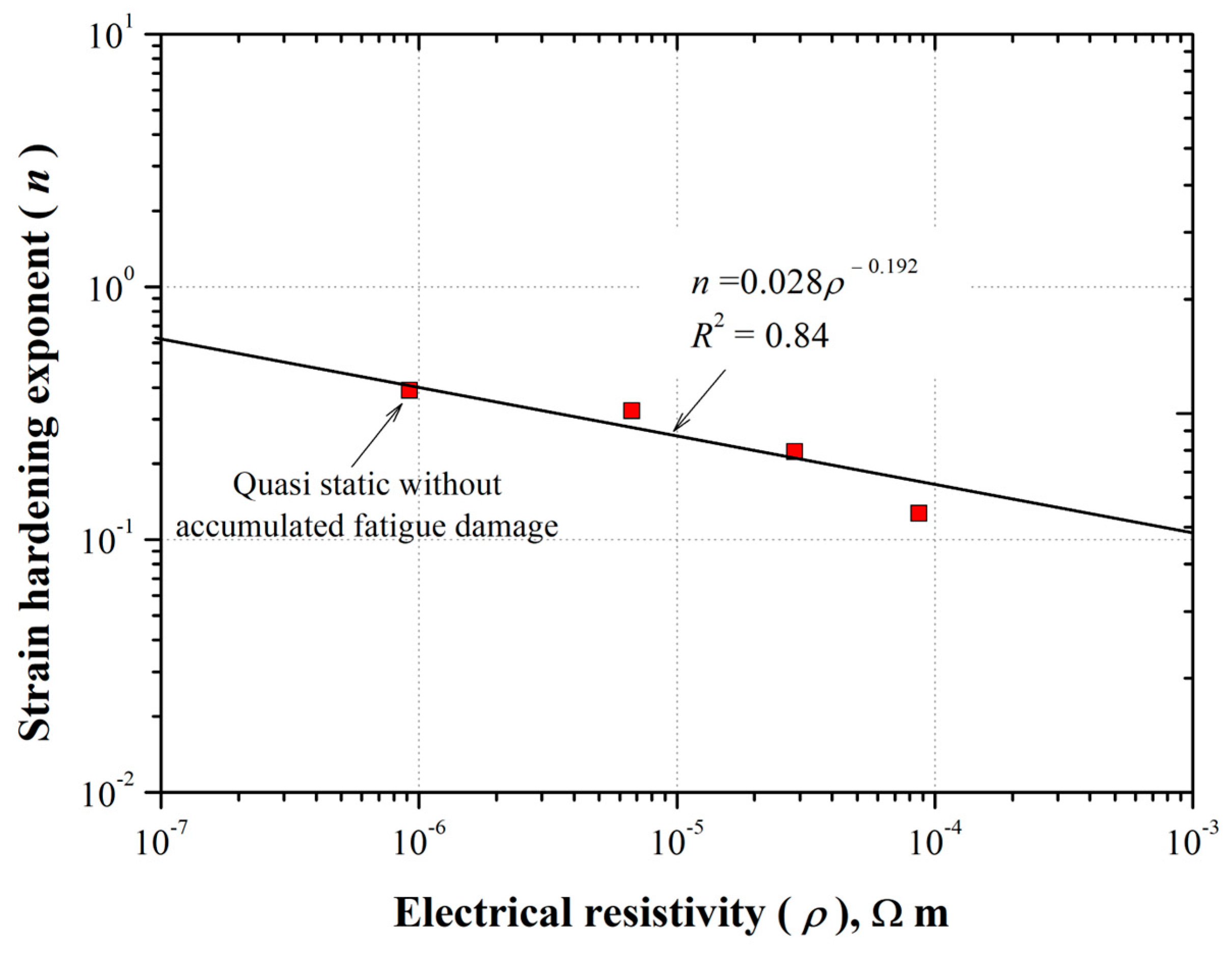
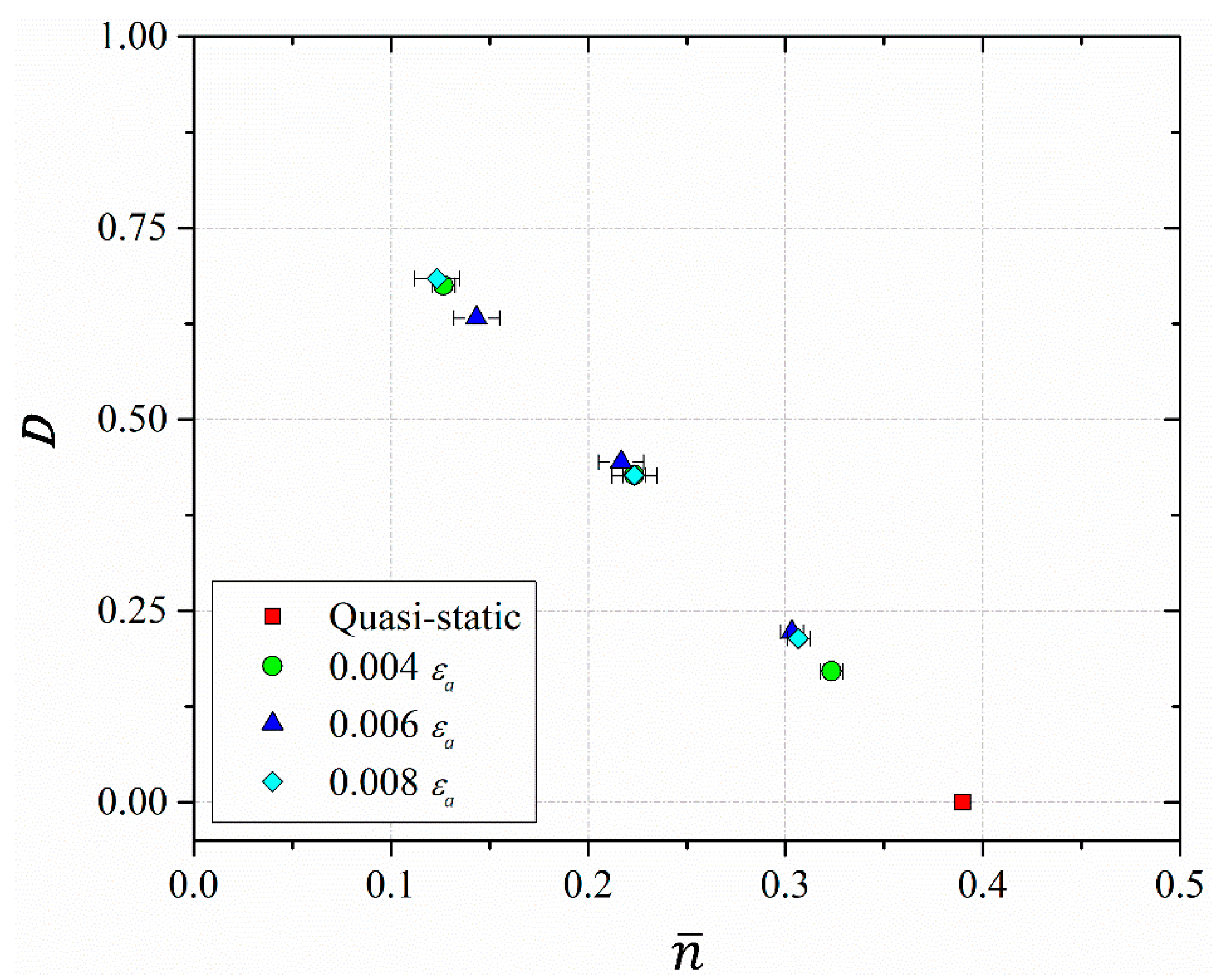
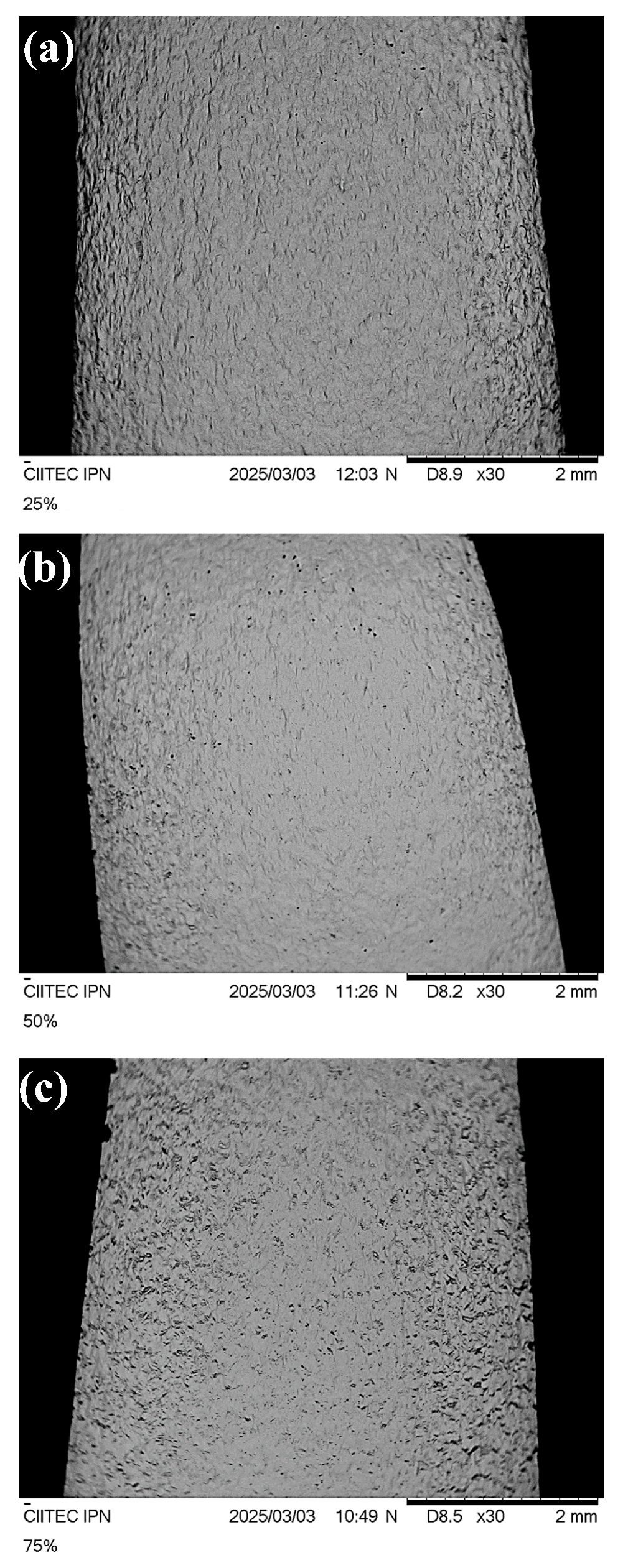
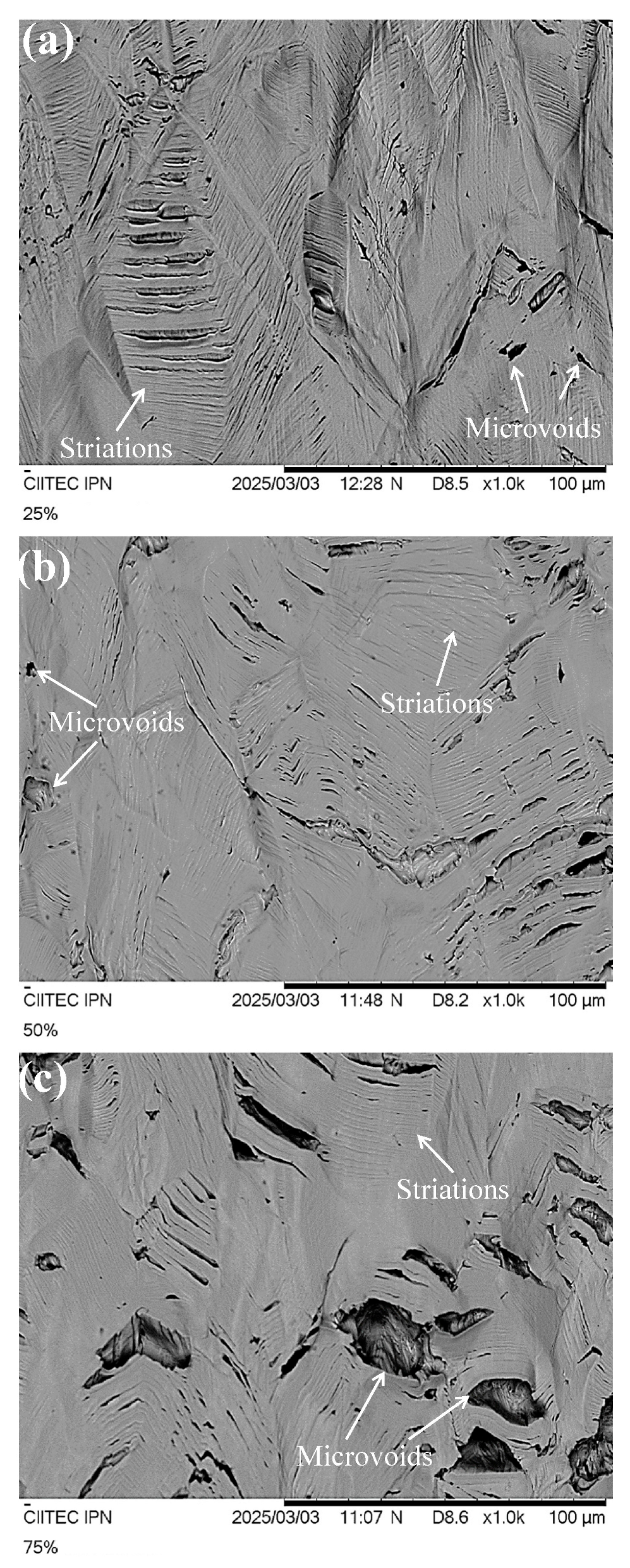
Disclaimer/Publisher’s Note: The statements, opinions and data contained in all publications are solely those of the individual author(s) and contributor(s) and not of MDPI and/or the editor(s). MDPI and/or the editor(s) disclaim responsibility for any injury to people or property resulting from any ideas, methods, instructions or products referred to in the content. |
© 2025 by the authors. Licensee MDPI, Basel, Switzerland. This article is an open access article distributed under the terms and conditions of the Creative Commons Attribution (CC BY) license (https://creativecommons.org/licenses/by/4.0/).
Share and Cite
Ramírez-Acevedo, D.; Ambriz, R.R.; García, C.J.; Gómora, C.M.; Jaramillo, D. Fatigue Damage Assessment in AL6XN Stainless Steel Based on the Strain-Hardening Exponent n-Value. Metals 2025, 15, 472. https://doi.org/10.3390/met15050472
Ramírez-Acevedo D, Ambriz RR, García CJ, Gómora CM, Jaramillo D. Fatigue Damage Assessment in AL6XN Stainless Steel Based on the Strain-Hardening Exponent n-Value. Metals. 2025; 15(5):472. https://doi.org/10.3390/met15050472
Chicago/Turabian StyleRamírez-Acevedo, Donovan, Ricardo Rafael Ambriz, Christian Jesús García, Cesar Mendoza Gómora, and David Jaramillo. 2025. "Fatigue Damage Assessment in AL6XN Stainless Steel Based on the Strain-Hardening Exponent n-Value" Metals 15, no. 5: 472. https://doi.org/10.3390/met15050472
APA StyleRamírez-Acevedo, D., Ambriz, R. R., García, C. J., Gómora, C. M., & Jaramillo, D. (2025). Fatigue Damage Assessment in AL6XN Stainless Steel Based on the Strain-Hardening Exponent n-Value. Metals, 15(5), 472. https://doi.org/10.3390/met15050472







